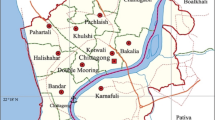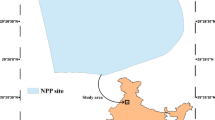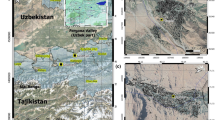Abstract
This paper highlights the seismic microzonation carried out for a nuclear power plant site. Nuclear power plants are considered to be one of the most important and critical structures designed to withstand all natural disasters. Seismic microzonation is a process of demarcating a region into individual areas having different levels of various seismic hazards. This will help in identifying regions having high seismic hazard which is vital for engineering design and land-use planning. The main objective of this paper is to carry out the seismic microzonation of a nuclear power plant site situated in the east coast of South India, based on the spatial distribution of the hazard index value. The hazard index represents the consolidated effect of all major earthquake hazards and hazard influencing parameters. The present work will provide new directions for assessing the seismic hazards of new power plant sites in the country. Major seismic hazards considered for the evaluation of the hazard index are (1) intensity of ground shaking at bedrock, (2) site amplification, (3) liquefaction potential and (4) the predominant frequency of the earthquake motion at the surface. The intensity of ground shaking in terms of peak horizontal acceleration (PHA) was estimated for the study area using both deterministic and probabilistic approaches with logic tree methodology. The site characterization of the study area has been carried out using the multichannel analysis of surface waves test and available borehole data. One-dimensional ground response analysis was carried out at major locations within the study area for evaluating PHA and spectral accelerations at the ground surface. Based on the standard penetration test data, deterministic as well as probabilistic liquefaction hazard analysis has been carried out for the entire study area. Finally, all the major earthquake hazards estimated above, and other significant parameters representing local geology were integrated using the analytic hierarchy process and hazard index map for the study area was prepared. Maps showing the spatial variation of seismic hazards (intensity of ground shaking, liquefaction potential and predominant frequency) and hazard index are presented in this work.










































Similar content being viewed by others
References
Anbazhagan P, Sitharam TG (2008) Seismic microzonation of Bangalore, India. J Earth Syst Sci 117:833–852
Anbazhagan P, Vinod JS, Sitharam TG (2009) Probabilistic seismic hazard analysis for Bangalore. Nat Hazards 48:145–166
Atkinson GM, Boore DM (2006) Earthquake ground-motion prediction equations for Eastern North America. Bull Seismol Soc Am 96(6):2181–2205
Baranwal M, Pathak B, Syiem SM (2005) Preliminary first level seismic microzonation of Guwahati. J Geophys 26(1):32–40
Barua A (2005) Generation of geological database for seismic microzonation of Dehradun. In: MSc thesis international institute for geo-information science and earth observations, Enschede, p 102
Beresnev IA, Atkinson GM (1998) Stochastic finite-fault modeling of ground motions from the 1994 Northridge California earthquake i validation on rock sites. Bull Seismol Soc Am 88(6):1392–1401
Bielak J, Xu J, Ghattas O (1999) Earthquake ground motion and structural response in alluvial valleys. J Geotech Geoenviron Eng 125(5):413–423
Bommer JJ, Scherbaum F, Bungum H, Cotton F, Sabetta F, Abrahamson NA (2005) On the use of logic trees for ground-motion prediction equations in seismic hazard analysis. Bull Seismol Soc Am 95:377–389
Bommer JJ, Papaspiliou M, Price W (2011) Earthquake response spectra for seismic design of nuclear power plants in the UK. Nucl Eng Des 241(3):968–977
Boominathan A, Koteswara Rao PC, Pillai CS, Hari S (2000) Measurement of dynamic properties and evaluation of liquefaction potential of a 500 mw prototype fast breeder reactor site located in South of India. In: 13th world conference on earthquake engineering
Boore D (1983) Stochastic simulation of high-frequency ground motions based on seismological models of the radiated spectra. Bull Seismol Soc Am 73(6A):1865–1894
Boore DM (2003) Simulation of ground motion using the stochastic method. Pure Appl Geophys 160:635–675
Borcherdt RD (1994) Estimates of site-dependent response spectra for design (methodology and justification). Earthq Spectra 10(4):617–653
Borcherdt RD, Gibbs JF (1976) Effects of local geological conditions in the San Francisco Bay region on ground motions and the intensities of the 1906 earthquake. Bull Seismol Soc Am 66:467–500
BSSC (2003) NEHRP recommended provisions for seismic regulations for new buildings and other structures (FEMA 450) Part 1. Provisions Building Seismic Safety Council for the Federal Emergency Management Agency, Washington DC
Campbell KW, Bozorgnia Y (2003) Updated near-source ground motion (attenuation) relations for the horizontal and vertical components of peak ground acceleration and acceleration response spectra. Bull Seismol Soc Am 93:314–331
Cetin KO, Seed RB, Kiureghian DA, Tokimastu K, Harder LF, Kayen RE, Moss RES (2004) Standard penetration test-based probabilistic and deterministic assessment of seismic soil liquefaction potential. J Geotech Geoenviron Eng 130(12):1314–1340
Chandra U (1977) Earthquakes of Peninsular India—a seismotectonic study. Bull Seismol Soc Am 67(5):1387–1413
Chetty TRK, Bhaskar Rao YJ (2006) The Cauvery shear zone, Southern Granulite Terrain, India: a crustal-scale flower structure. Gondwana Res 10(1):77–85
Chin KH DuRee B Trent W, Ordonez G (2010) Evaluation of seismic response of a site class F site using equivalent linear and nonlinear computer codes. In: 5th conference on recent advances in geotechnical earthquake engineering and soil dynamics. Missouri University of Science and Technology
Cornell CA (1968) Engineering seismic risk analysis. Bull Seismol Soc Am 58:1583–1606
Costa G, Panza GF, Suhadolc P, Vaccari F (1993) Zoning of the Italian territory in terms of expected peak ground acceleration derived from complete synthetic seismograms. In: Cassinis R, Helbig K, Panza GF (eds) Geophysical exploration in areas of complex geology II. Journal of Applied Geophysics 30:149–160
Feng-xin Z, Yu-shan Z (2006) Artificial ground motion compatible with specified peak velocity and target spectrum. Acta Seismol Sin 19(4):461–471
Frankel A (1995) Mapping seismic hazard in the Central Eastern United States. Seismol Res Lett 66(4):8–21
Gangrade BK, Arora SK (2000) Seismicity of the Indian Peninsular Shield from regional earthquake data. Pure Appl Geophys 157:1683–1705
Gazetas G, Dakoulas P (1992) Seismic analysis and design of rockfill dams: state-of-the-art. Soil Dyn Earthq Eng 11:27–61
Ghosh AK (2006) Probabilistic seismic hazard analysis for a site. Nucl Eng Des 236(11):1192–1200
Gulati B (2006) Earthquake risk assessment of buildings: applicability of HAZUS in Dehradun India. In: MSc thesis, international institute for geo-information science and earth observations, Enschede
Gupta ID (2002) The state of the art in seismic hazard analysis. ISET J Earthq Tech 39(4):311–346
Gurumoorthy C, Sasidhar P, Arumugham V, Mathur RK (2004) Sub-surface investigations on deep saline groundwater of charnockite rock formation Kalpakkam India. Environ Monit Assess 91:211–222
Gutenberg B, Richter CF (1944) Frequency of earthquakes in California. Bull Seismol Soc Am 34:185–188
Hartzell S (1978) Earthquake aftershocks as Green’s functions. Geophys Res Lett 5(1):1–4
Heaton TH, Tajima F, Mori AW (1986) Estimating ground motions using recorded accelerograms. Surv Geophys 8(1):25–83
Hwang HHM (1988) Seismic probabilistic risk assessment and seismic margins studies for nuclear power plants. Probab Eng Mech 3(4):170–178
Idriss IM, Boulanger RW (2006) Semi-empirical procedures for evaluating liquefaction potential during earthquakes. Soil Dyn Earthq Eng 26:115–130
Irikura K (1983) Semi-empirical estimation of strong ground motions during large earthquakes. Bull Disas Prev Res Inst 33:63–104
Iyengar RN, Ghosh S (2004) Microzonation of earthquake hazard in greater Delhi area. Curr Sci 87:1193–1202
Jaiswal K, Sinha R (2007) Probabilistic seismic-hazard estimation for peninsular India. Bull Seismol Soc Am 97(1B):318–330
Kaila KL, Gaur VK, Hari N (1972) Quantitative seismicity maps of India. Bull Seismol Soc Am 62:1119–1131
Kau MK (1978) Stochastic characterization of earthquakes through their response spectrum. Earthq Eng Struct Dyn 6(5):497–509
Kennedy RP, Cornell CA, Campbell RD, Kaplan S, Perla HF (1980) Probabilistic seismic safety study of an existing nuclear power plant. Nucl Eng Des 59(2):315–338
Kramer SL (1996) Geotechnical earthquake engineering. Pearson Education Pvt Ltd. Reprinted 2003 Delhi
Kramer SL, Mayfield RT (2007) Return period of soil liquefaction. J Geotech Geoenviron Eng 133(7):802–813
Krinitzsky EL (1995) Deterministic versus probabilistic seismic hazard analysis for critical structures. Eng Geol 40(1):1–7
Krinitzsky EL (2002) How to obtain earthquake ground motions for engineering design. Eng Geol 65:1–16
Kumar A (2006) Software for generation of spectrum compatible time history. In: 13th world conference on earthquake engineering paper no 2096
Liao SSC, Whitman RV (1986) Catalogue of liquefaction and non-liquefaction occurrences during earthquakes. Res Rep Dept of Civ Eng. Massachusetts Institute of Technology, Cambridge
Meert JG, Pandit MK, Pradhan VR, Banks J, Sirianni R, Stroud M, Gifford J (2010) Precambrian crustal evolution of Peninsular India: a 3.0 billion year odyssey. J Asian Earth Sci 39(6):483–515
Menon A, Ornthammarath T, Corigliano M, Lai CG (2010) Probabilistic seismic hazard macrozonation of Tamil Nadu in Southern India. Bull Seismol Soc Am 100(3):1320–1341
Midorikawa S (1987) Prediction of isoseismal map in the Kanto plain due to hypothetical earthquake. J Struct Eng 33B:43–48
Mohanty WK, Verma AK (2013) Probabilistic seismic hazard analysis for Kakrapar atomic power station, Gujarat, India. Nat Hazards 69(1):919–952
Mohanty WK, Walling MY, Nath SK, Pal I (2007) First order seismic microzonation of Delhi India using geographic information system (GIS). Nat Hazards 40(2):245–260
Mukhopadhyay S, Pandey Y, Dharmaraju R, Chauhan PKS, Singh P, Dev A (2002) Seismic microzonation of Delhi for ground shaking site effects. Curr Sci 82:877–881
Naqvi SM, Rogers JJ (1987) Precambrian geology of India; Oxford monographs on geology and geophysics, no. 6, Oxford University Press, p 223
Narayan JP, Sharma ML (2004) Effects of local geology on damage severity during Bhuj India earthquake. In: 13th world conference on earthquake engineering, Vancouver
Nath SK (2004) Seismic hazard mapping and microzonation in the Sikkim Himalaya through GIS integration of site effects and strong ground motion attributes. Nat Hazards 31(2):319–342
Nath SK, Thingbaijam SKK, Raj A (2008) Earthquake hazard in Northeast India—a seismic microzonation approach with typical case studies from Sikkim Himalaya and Guwahati city. J Earth Syst Sci 117:809–831
NDMA (2011) Geotechnical/geophysical investigations for seismic microzonation studies of Urban Centres in India Technical Report to National Disaster Management Authority Govt of India
Ordonez GA (2000) SHAKE 2000: a computer program for the 1D analysis of geotechnical earthquake engineering problems. http://www.shake2000.com
Panza GF, Vaccari F, Cazzaro R (1999) Deterministic seismic hazard assessment. In: Wenzel F et al. (eds) Vrancea earthquakes tectonic and risk mitigation. Kluwer, The Netherlands, pp 269–286
Park CB, Miller RD, Xia J (1999) Multi-channel analysis of surface waves. Geophysics 64(3):800–808
Park CB, Heljeson MA, Ivanov J, Brohammer M (2007) Surfseis user’s manual v 2.0 Kansas Geological Survey USA
PCRSMJUA (2005) Project completion report of seismic microzonation of Jabalpur Urban Area. Department of Science and Technology Government of India
Radhakrishna BP (1989) Suspect tectono-stratigraphic terrane elements in the Indian subcontinent. J Geol Soc India 34(1):24
Raghu Kanth STG, Iyengar RN (2006) Seismic hazard estimation for Mumbai city. Curr Sci 91(11):1486–1494
Raghu Kanth STG, Iyengar RN (2007) Estimation of seismic spectral acceleration in Peninsular India. J Earth Syst Sci 116(3):199–214
Ram A, Rathor HS (1970) On frequency magnitude and energy of significant Indian earthquakes. Pure Appl Geophys 79:26–32
Ramalingeswara Rao B (2000) Historical seismicity and deformation rates in the Indian Peninsular shield. J Seismol 4:247–258
Ramalingeswara Rao B, Sitapathi Rao P (1984) Historical Seismicity of Peninsular India. Bull Seismol Soc Am 74:2519–2533
Ramasamy SM (2006) Remote sensing and active tectonics of South India. Int J Remote Sens 27(20):4397–4431
Ranjan R (2005) Seismic response analysis of Dehradun city India. In: MSc thesis, international institute for geo-information science and earth observations, Enschede, p 86
Rao KS, Neelima Satyam D (2005) Seismic microzonation studies for Delhi region. In: Symposium on seismic hazard analysis and microzonation, Roorkee, pp 213–234
Reiter L (1990) Earthquake hazard analysis: issues and insights. Columbia University Press
Rao VV, Sain K, Reddy PR, Mooney WD (2006) Crustal structure and tectonics of the northern part of the Southern Granulite Terrane, India. Earth Planet Sci Lett 251(1):90–103
Robertson PK, Wride CE (1997) Cyclic liquefaction and its evaluation based on the SPT and CPT. In: Proceedings of the NCEER workshop on evaluation of liquefaction resistance of soils: technical report NCEER-97-0022. National Center for Earthquake Engineering Research, Buffalo, pp 41–87
Rollins KM, Evans MD, Diehl NB, Daily WD III (1998) Shear modulus and damping relationships for gravels. J Geotech Geoenviron Eng 124(5):396–405
Roshan AD, Basu PC (2010) Application of PSHA in low seismic region: a case study on NPP site in peninsular India. Nucl Eng Des 240(10):3443–3454
Saaty TL (1980) The analytic hierarchy process. McGraw-Hill, New York
Savy J, Bernreuter D, Mensing R (1990) Probabilistic assessment of the seismic hazard for Eastern United States nuclear power plants. Nucl Eng Des 123:99–109
Schnabel PB (1973) Effect of local geology and distance from source on earthquake ground motions In: PhD Thesis University of California Berkeley, California
Schnabel PB, Lysmer J, Seed HB (1972) SHAKE: a computer program for earthquake response analysis of horizontally layered sites earthquake engineering. Research Center University of California Berkeley. Report No. UCB/EERC-72/12, p 102
Scordilis EM (2006) Empirical global relations converting Ms and mb to moment magnitude. J seismol 10(2):225–236
Seed HB, Idriss IM (1970) Soil moduli and damping factors for dynamic response analysis. Report no. EERC 70-10. University of California, Berkeley
Seed HB, Idriss IM (1971) Simplified procedure for evaluating soil liquefaction potential. J Soil Mech Found 97:1249–1273
Seed HB, Idriss I M (1969) The influence of soil conditions on ground motions during earthquakes. J Soil Mech Found Eng Div ASCE No 94:93–137
Seed HB, Sun JH (1989) Implication of site effects in the Mexico City earthquake of September 19 1985 for earthquake-resistance-design criteria in the San Francisco Bay area of California report no. UCB/EERC-89/03. University of California Berkeley California
Seed HB, Idriss IM, Arango I (1983) Evaluation of liquefaction potential using field performance data. J Geotech Eng 9(3):458–482
SEISAT (2000) Seismotectonic atlas of India. Geological Survey of India, New Delhi
Seo JM, Noh M, Chang CJ, Yun KH (2009) Status of the PSHA in Korea for nuclear power plant sites. Nucl Eng Technol 41(10):1255–1262
Shima E (1978) Seismic microzoning map of Tokyo. In: Proceedings of the 2nd international conference on microzonation, vol 1, pp 433–443
Sitharam TG, Anbazhagan P (2008) Seismic microzonation: principles practices and experiments. Electron J Geotech Eng Spec. Volume Bouquet 08 online http://www.ejge.com/Bouquet08/Preface.htm. p 61
Sitharam TG, Anbazhagan P, Ganesha Raj K (2006) Use of remote sensing and seismotectonic parameters for seismic hazard analysis of Bangalore. Nat Hazards Earth Syst Sci 6:927–939
Sitharam TG, Vipin KS (2011) Evaluation of spatial variation of peak ground acceleration and spectral acceleration for South India: probabilistic approach. Nat Hazards 59(2):639–653
Skempton AW (1986) Standard penetration test procedures and the effects in sands of overburden pressure relative density particle size ageing and overconsolidation. Geotechnique 36(3):425–447
Stepp JC (1972) Analysis of the completeness of the earthquake sample in the Puget Sound area and its effects on statistical estimates of earthquakes hazard. In: Proceedings of the international conference of microzonation for safer construct research application, vol 64, no. 4, Seattle, pp 1189–1207
Stewart JP, Liu AH, Choi Y (2003) Amplification factors for spectral acceleration in tectonically active regions. Bull Seismol Soc Am 93(1):332–352
Vipin KS, Anbazhagan P, Sitharam TG (2009) Estimation of peak ground acceleration and spectral acceleration for South India with local site effects: probabilistic approach. Nat Hazards Earth Syst Sci 9:865–878
Vucetic M, Dobry R (1991) Effect of soil plasticity on cyclic response. J Geotech Eng ASCE 117(1):89–107
Wiemer S, García-Fernández M, Burg JP (2009) Development of a seismic source model for probabilistic seismic hazard assessment of nuclear power plant sites in Switzerland: the view from PEGASOS Expert Group 4 (EG1d). Swiss J Geosci 102(1):189–209
Youd TL, Perkins DM (1978) Mapping of liquefaction induced ground failure potential. J Geotech Eng Div 104(4):433–446
Youd TL, Idriss IM, Andrus RD, Arango I, Castro G, Christian JT et al. (2001) Liquefaction resistance of soils: summary report from the 1996 NCEER and 1998 NCEER/NSF workshops on evaluation of liquefaction resistance of soils. J Geotech Geoenviron Eng 127(10):817–833
Acknowledgments
Authors thank Indira Gandhi Center for Atomic Research (IGCAR), Kalppakkam, India, for funding the project titled ‘Probabilistic Evaluation of Liquefaction Potential with Local Site Effect’ (Ref. No. CIE/TGS/MCV/IGCAR/001).
Author information
Authors and Affiliations
Corresponding author
Rights and permissions
About this article
Cite this article
James, N., Sitharam, T.G., Padmanabhan, G. et al. Seismic microzonation of a nuclear power plant site with detailed geotechnical, geophysical and site effect studies. Nat Hazards 71, 419–462 (2014). https://doi.org/10.1007/s11069-013-0919-0
Received:
Accepted:
Published:
Issue Date:
DOI: https://doi.org/10.1007/s11069-013-0919-0




